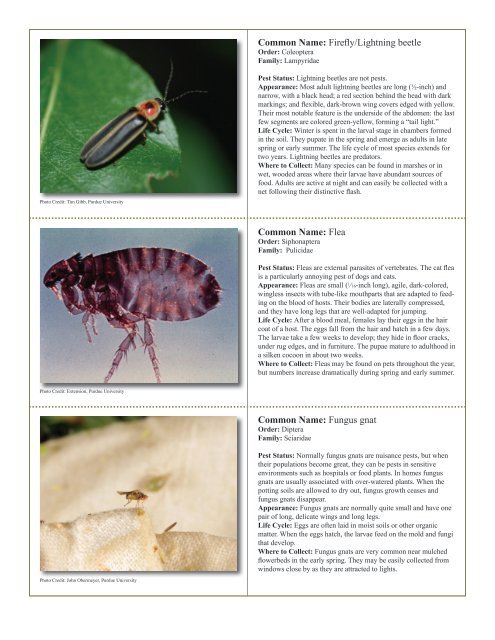to download pdf - Purdue Extension Entomology - Purdue University
to download pdf - Purdue Extension Entomology - Purdue University
to download pdf - Purdue Extension Entomology - Purdue University
Create successful ePaper yourself
Turn your PDF publications into a flip-book with our unique Google optimized e-Paper software.
Common Name: Firefly/Lightning beetle<br />
Order: Coleoptera<br />
Family: Lampyridae<br />
Pho<strong>to</strong> Credit: Tim Gibb, <strong>Purdue</strong> <strong>University</strong><br />
Pest Status: Lightning beetles are not pests.<br />
Appearance: Most adult lightning beetles are long (½-inch) and<br />
narrow, with a black head; a red section behind the head with dark<br />
markings; and flexible, dark-brown wing covers edged with yellow.<br />
Their most notable feature is the underside of the abdomen: the last<br />
few segments are colored green-yellow, forming a “tail light.”<br />
Life Cycle: Winter is spent in the larval stage in chambers formed<br />
in the soil. They pupate in the spring and emerge as adults in late<br />
spring or early summer. The life cycle of most species extends for<br />
two years. Lightning beetles are preda<strong>to</strong>rs.<br />
Where <strong>to</strong> Collect: Many species can be found in marshes or in<br />
wet, wooded areas where their larvae have abundant sources of<br />
food. Adults are active at night and can easily be collected with a<br />
net following their distinctive flash.<br />
Common Name: Flea<br />
Order: Siphonaptera<br />
Family: Pulicidae<br />
Pest Status: Fleas are external parasites of vertebrates. The cat flea<br />
is a particularly annoying pest of dogs and cats.<br />
Appearance: Fleas are small ( 1 ⁄16-inch long), agile, dark-colored,<br />
wingless insects with tube-like mouthparts that are adapted <strong>to</strong> feeding<br />
on the blood of hosts. Their bodies are laterally compressed,<br />
and they have long legs that are well-adapted for jumping.<br />
Life Cycle: After a blood meal, females lay their eggs in the hair<br />
coat of a host. The eggs fall from the hair and hatch in a few days.<br />
The larvae take a few weeks <strong>to</strong> develop; they hide in floor cracks,<br />
under rug edges, and in furniture. The pupae mature <strong>to</strong> adulthood in<br />
a silken cocoon in about two weeks.<br />
Where <strong>to</strong> Collect: Fleas may be found on pets throughout the year,<br />
but numbers increase dramatically during spring and early summer.<br />
Pho<strong>to</strong> Credit: <strong>Extension</strong>, <strong>Purdue</strong> <strong>University</strong><br />
Common Name: Fungus gnat<br />
Order: Diptera<br />
Family: Sciaridae<br />
Pest Status: Normally fungus gnats are nuisance pests, but when<br />
their populations become great, they can be pests in sensitive<br />
environments such as hospitals or food plants. In homes fungus<br />
gnats are usually associated with over-watered plants. When the<br />
potting soils are allowed <strong>to</strong> dry out, fungus growth ceases and<br />
fungus gnats disappear.<br />
Appearance: Fungus gnats are normally quite small and have one<br />
pair of long, delicate wings and long legs.<br />
Life Cycle: Eggs are often laid in moist soils or other organic<br />
matter. When the eggs hatch, the larvae feed on the mold and fungi<br />
that develop.<br />
Where <strong>to</strong> Collect: Fungus gnats are very common near mulched<br />
flowerbeds in the early spring. They may be easily collected from<br />
windows close by as they are attracted <strong>to</strong> lights.<br />
Pho<strong>to</strong> Credit: John Obermeyer, <strong>Purdue</strong> <strong>University</strong>
















